Samsung Electronics Co SGHX490 Single-Band PCS GSM Phone User Manual SGH X497 FCC
Samsung Electronics Co Ltd Single-Band PCS GSM Phone SGH X497 FCC
Contents
- 1. Users Manual 1
- 2. Users Manual 2
Users Manual 1

UCEC2.01_PMx490_033005_D1
SGH-X490_Draft
PORTABLE Tri/Dual-
Mode
TELEPHONE
User Guide
Please read this manual before operating your
phone, and keep it for future reference.
x497.book Page 1 Wednesday, March 30, 2005 5:22 PM

Intellectual Property
All Intellectual Property, as defined below, owned by or which is
otherwise the property of Samsung or its respective suppliers
relating to the SAMSUNG Phone, including but not limited to,
accessories, parts, or software relating there to (the “Phone
System”), is proprietary to Samsung and protected under federal
laws, state laws, and international treaty provisions. Intellectual
Property includes, but is not limited to, inventions (patentable or
unpatentable), patents, trade secrets, copyrights, software,
computer programs, and related documentation and other
works of authorship. You may not infringe or otherwise violate
the rights secured by the Intellectual Property. Moreover, you
agree that you will not (and will not attempt to) modify, prepare
derivative works of, reverse engineer, decompile, disassemble,
or otherwise attempt to create source code from the software. No
title to or ownership in the Intellectual Property is transferred to
you. All applicable rights of the Intellectual Property shall
remain with SAMSUNG and its suppliers.
Samsung Telecommunications America (STA),
Inc.
Headquarters: Customer Care Center:
1301 E. Lookout Drive 1601 E. Plano Parkway, Suite 150
Richardson, TX 75082 Plano, TX 75074
Tel: 972.761.7000 Toll Free Tel: 1.888.987.HELP (4357)
Internet Address: http://www.samsungusa.com
©2005 Samsung Telecommunications America, Inc. is a
registered trademark of Samsung Electronics America, Inc. and
its related entities.
x497.book Page 2 Wednesday, March 30, 2005 5:22 PM
GH68-xxxx
Openwave® is a registered Trademark of Openwave, Inc.
RSA® is a registered Trademark RSA Security, Inc.
Disclaimer of Warranties; Exclusion of Liability
EXCEPT AS SET FORTH IN THE EXPRESS WARRANTY
CONTAINED ON THE WARRANTY PAGE ENCLOSED WITH
THE PRODUCT, THE PURCHASER TAKES THE PRODUCT "AS
IS", AND SAMSUNG MAKES NO EXPRESS OR IMPLIED
WARRANTY OF ANY KIND WHATSOEVER WITH RESPECT
TO THE PRODUCT, INCLUDING BUT NOT LIMITED TO THE
MERCHANTABILITY OF THE PRODUCT OR ITS FITNESS FOR
ANY PARTICULAR PURPOSE OR USE; THE DESIGN,
CONDITION OR QUALITY OF THE PRODUCT; THE
PERFORMANCE OF THE PRODUCT; THE WORKMANSHIP
OF THE PRODUCT OR THE COMPONENTS CONTAINED
THEREIN; OR COMPLIANCE OF THE PRODUCT WITH THE
REQUIREMENTS OF ANY LAW, RULE, SPECIFICATION OR
CONTRACT PERTAINING THERETO. NOTHING
CONTAINED IN THE INSTRUCTION MANUAL SHALL BE
CONSTRUED TO CREATE AN EXPRESS OR IMPLIED
WARRANTY OF ANY KIND WHATSOEVER WITH RESPECT
TO THE PRODUCT. IN ADDITION, SAMSUNG SHALL NOT BE
LIABLE FOR ANY DAMAGES OF ANY KIND RESULTING
FROM THE PURCHASE OR USE OF THE PRODUCT OR
ARISING FROM THE BREACH OF THE EXPRESS WARRANTY,
INCLUDING INCIDENTAL, SPECIAL OR CONSEQUENTIAL
DAMAGES, OR LOSS OF ANTICIPATED PROFITS OR
BENEFITS.
x497.book Page 3 Wednesday, March 30, 2005 5:22 PM

Section 1: Getting Started 5
Section 1
Section 1: Getting Started
Topics Covered
• Activating Your Phone
• Setting Up Voicemail
This section allows you to start using your phone by
activating your service and setting up your voice mail.
x497.book Page 5 Wednesday, March 30, 2005 5:22 PM

6
Section 1
Activating Your Phone
When you subscribe to a cellular network, you are
provided with a plug-in SIM card loaded with your
subscription details, such as your PIN, any optional
services available, and many others.
Installing the SIM Card
Important! The plug-in SIM card and its contacts can be easily damaged
by scratches or bending, so be careful when handling, inserting, or
removing the card.
Keep all SIM cards out of reach of small children.
If necessary, switch off the phone by holding down the
key until the power-off image displays.
Remove the battery. To do so:
1. Slide the battery lock toward the top of the phone and
hold it in that position.
2. Lift the battery away, as shown.
3. Slide the SIM card into the SIM card socket so that the
card locks into place. Make sure the gold contacts of the
card face into the phone.
x497.book Page 6 Wednesday, March 30, 2005 5:22 PM
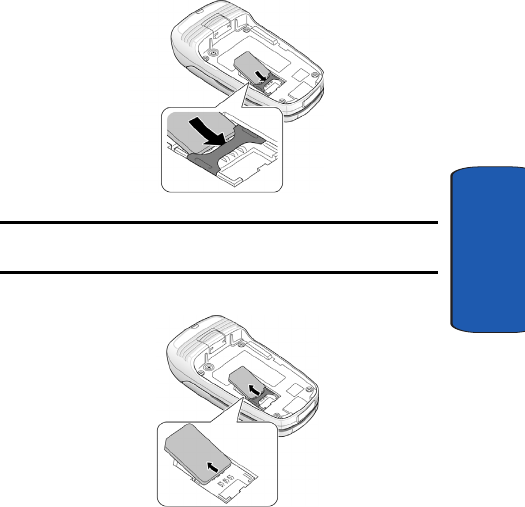
Section 1: Getting Started 7
Activating Your Phone
Section 1
Note: When you need to remove the SIM card, slide it, as shown, and take
it out of the socket.
4. Place the battery so that the tabs on the end align with
the slots at the bottom of the phone.
x497.book Page 7 Wednesday, March 30, 2005 5:22 PM
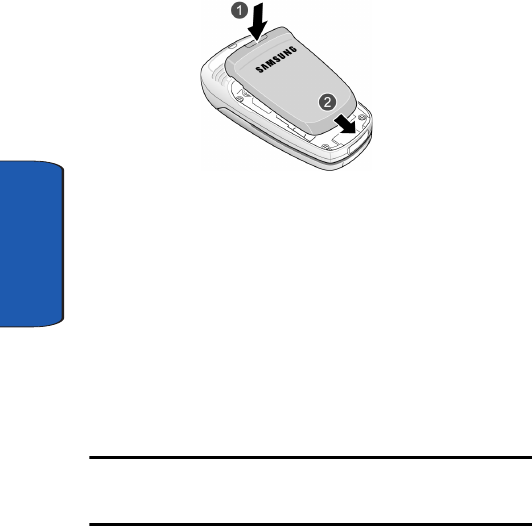
8
Section 1
5. Press the battery down until it clicks into place. Make
sure that the battery is properly installed before
switching on the phone.
Charging a Battery
Your phone is powered by a rechargeable Li-ion battery. A
travel adapter comes with your phone for charging the
battery. Use only approved batteries and chargers. Ask
your local Samsung dealer for further details.
You can use the phone while the battery is charging, but
this causes the phone to charge more slowly.
Note: You must fully charge the battery before using your phone for the
first time. A discharged battery recharges fully in approximately
200 minutes.
1. With the battery in position on the phone, plug the
connector of the travel adapter into the jack at the
bottom of the phone.
x497.book Page 8 Wednesday, March 30, 2005 5:22 PM
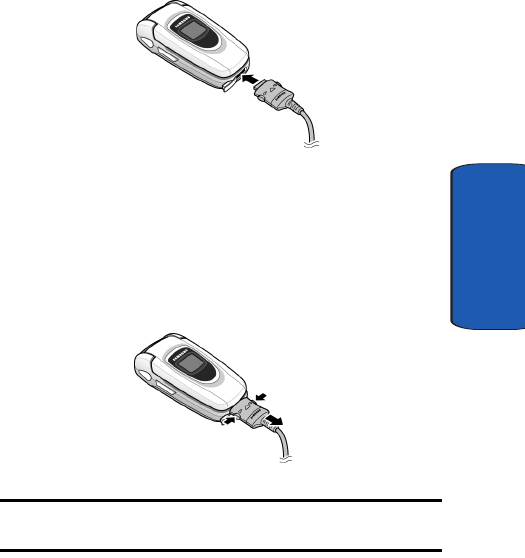
Section 1: Getting Started 9
Activating Your Phone
Section 1
2. Plug the adapter into a standard AC wall outlet.
3. When charging is finished, unplug the adapter from the
power outlet and disconnect it from the phone by
pressing the buttons on both sides of the connector and
pulling the connector out.
Note: You must unplug the adapter before you remove the battery from the
phone during charging; otherwise, the phone could be damaged.
Low Battery Indicator
When the battery is weak and only a few minutes of talk
time remain, a warning tone sounds and the “Warning
Low Battery” message repeats at regular intervals on the
x497.book Page 9 Wednesday, March 30, 2005 5:22 PM

10
Section 1
display. When this happens, your phone turns off the
backlight to conserve the remaining battery power.
When the battery level becomes too low, the phone
automatically turns off.
Switching On or Off the Phone
1. Open the phone.
2. Press and hold the key until the phone switches on.
3. If the phone asks you to enter the phone password, enter
the password and press the OK soft key or the key.
The password is preset to “00000000” at the factory. For
further details, see "Change Password" on page 89.
4. If the phone asks for a PIN, enter the PIN and press the
OK soft key or the key. For further details, see "PIN
Check" on page 88.
The phone searches for your network and after finding it,
the Idle screen appears. Now, you can make or receive
calls.
Note: The display language is preset to English at the factory. To change
the language, use the Language menu. For further details, see "Language
Settings" on page 87.
5. When you wish to switch off the phone, press and hold
the key until the power-off image displays.
Setting Up Your Voice Mail
To access you voice mail from your keypad, use the
following steps:
1. Open the phone to access your keypad.
x497.book Page 10 Wednesday, March 30, 2005 5:22 PM

Section 1: Getting Started 11
Setting Up Your Voice Mail
Section 1
2. From an Idle screen, press and hold the key.
3. Follow the voice mail prompts to access messages.
Accessing Your Voice Mail
1. In Idle mode, press the Menu soft key to access Menu
mode.
2. Highlight Recent Calls and press the key.
3. Highlight Voice mail and press the key.
4. Highlight Call voice mail and press the key. Your
phone dials the specified voice mail number.
5. When connected, follow the voice prompts from the
voice mail center.
Changing the Voice Mail Number
Your SIM card gives you default service number of the
voice mail center. However, you may need to change the
number. Use the following procedures to change your
voice mail number.
1. In Idle mode, press the Menu soft key to access the
Menu mode.
2. Highlight Recent Calls and press the key.
3. Highlight Voice mail and press the key.
4. Highlight Voice server number and press the key.
Select the Voice server 1 or 2 options and press the
key.
5. Press the Edit soft key to change the number.
6. Press the OK soft key to save the update.
7. Press the key to return to Idle mode.
x497.book Page 11 Wednesday, March 30, 2005 5:22 PM

12
Section 1
x497.book Page 12 Wednesday, March 30, 2005 5:22 PM

Section 2: Understanding Your Phone 13
Section 2
Section 2: Understanding Your Phone
Topics Covered
• Features of Your Phone
• Front View of Your Phone
• Command Keys
• Understanding the Display Screen
This section outlines some key features of your phone. It
also displays the screen and the icons that are displayed
when the phone is in use.
x497.book Page 13 Wednesday, March 30, 2005 5:22 PM
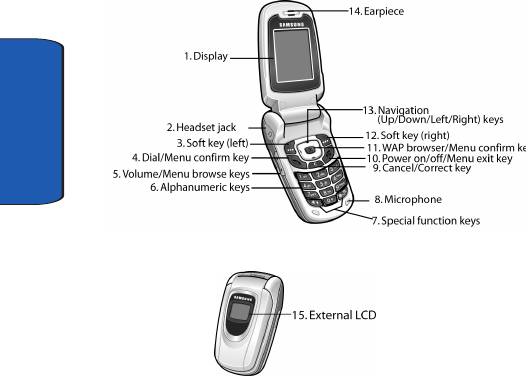
14
Section 2
Features of Your Phone
Your phone is lightweight, easy-to-use and offers many
significant features. The following list outlines a few of the
features included in your phone.
User friendly, menu driven access to features and options.
• Instant Messaging capability
• Multimedia capability
• Personal Assistant feature provides calendar, to-do list, alarms,
calculator, and currency exchange.
Front View of Your Phone
The following illustrations show the main elements of
your phone:
x497.book Page 14 Wednesday, March 30, 2005 5:22 PM

Section 2: Understanding Your Phone 15
Keys
Section 2
Keys
The following list correlates to the from and rear
illustrations.
1. Display area where text and graphics are displayed.
2. The headset jack is used for the hands-free headset.
3. Performs the functions indicated by the screen text on
the bottom line of the display.
4. Makes or answers a call.
In Idle mode, recalls the last number dialed or received
when held down.
In Menu mode, selects a menu function or stores
information that you have entered, such as a name in the
phone or SIM memory.
5. During a call, adjusts the earpiece volume.
In Idle mode with the phone open, adjusts the ring
volume. With the phone closed, turns on the external
display when held down.
6. Enters numbers, letters, and some special characters.
7. Enters special characters. Performs various functions.
8. The microphone used during phone calls and voice
memo recordings.
9. Deletes characters from the display.
In Menu mode, returns you to the previous menu level.
x497.book Page 15 Wednesday, March 30, 2005 5:22 PM

16
Section 2
10.Ends a call. Also switches the phone on and off when
held down.
In Menu mode, cancels your input and returns the phone
to Idle mode.
11.In Idle mode, launches the WAP (Wireless Application
Protocol) browser.
In Menu mode, selects the highlighted menu options.
12.Performs the functions indicated by the screen text on
the bottom line of the display.
13.In Menu mode, scrolls through the menus and Phone
book.
In Idle mode, the Down key allows you to access the
Phone book menu directly.
When entering text, moves the cursor to the left or right,
depending on which side you push.
14.The earpiece is used to listen to audio from your phone.
15.The external display shows the received signal strength,
the phone battery level, the date and time.
x497.book Page 16 Wednesday, March 30, 2005 5:22 PM
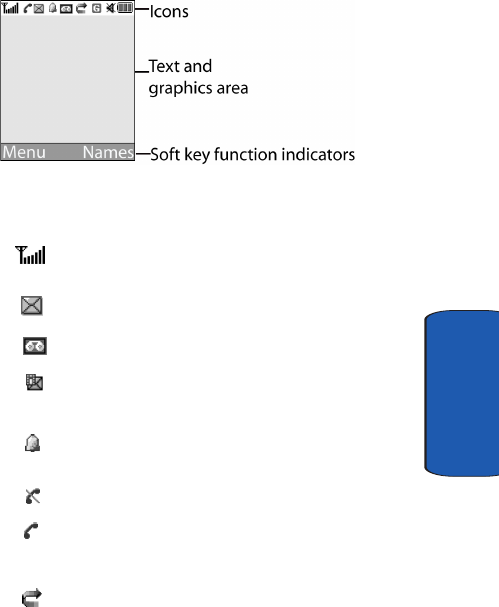
Section 2: Understanding Your Phone 17
Display Layout
Section 2
Display Layout
The display has 3 areas:
Icons
Shows the received signal strength. The greater the
number of bars, the stronger the signal.
Appears when a new text message has been received.
Appears when a new voice mail has been received.
Appears when a new multimedia message has been
received.
Appears when you set an alarm to ring at a specified
time. For details, see page "Alarm" on page 98.
Appears when you are out of your service area.
Appears when a call is in progress.
Appears when you are connected to a WAP service.
Appears when the Call Forwarding feature is active. For
details, see page "Call Forwarding" on page 92.
x497.book Page 17 Wednesday, March 30, 2005 5:22 PM

18
Section 2
Appears when Silent mode is active or you set the phone
to vibrate when you receive a call.
Appears when Mute mode is active.
Shows the level of your battery. The more bars you see,
the more power you have remaining.
Backlight
A backlight illuminates the display and the keypad.
When you press any key or open the phone, the backlight
comes on. It goes off when no keys are pressed within a
given period of time, depending on the setting in the Back
light menu. The display turns off after one minute to
conserve battery power.
To specify the length of time the backlight is active, set the
Back light menu. See "Backlight" on page 84 for further
details.
External Display
Your phone has an external display on the front of the
phone. It indicates when you have an incoming call or
message. It also alerts you at a specified time when you
have set an alarm. The backlight turns on and the
corresponding icon appears on the external display.
When you close the phone, the display shows the current
time on a digital clock.
x497.book Page 18 Wednesday, March 30, 2005 5:22 PM

Section 3: Call Functions 19
Section 3
Section 3: Call Functions
Topics Covered
• Making a Call
• Adjusting the Call Volume
• Answering a Call
•Call Log
• Silent Mode
This section allows you to make or answer a call. It also
includes the features and functionality associated with
making or answering a call.
x497.book Page 19 Wednesday, March 30, 2005 5:22 PM

20
Section 3
Making a Call
When the idle screen displays, enter the area code and
phone number, and press the key.
Note: When you activate the Auto redial option in the Extra settings menu,
the phone will automatically redial up to 10 times when the person does
not answer the call or is already on the phone. See page "Extra Settings"
on page 100 for further details.
Making an International Call
1. Press and hold the 0 key. The + character appears.
2. Enter the country code, area code, and phone number
and press the key.
Correcting the Number
1. To clear the last digit displayed, press the C key.
2. To clear any other digit in the number, press the Left or
Right key until the cursor is immediately to the right of
the digit to be cleared. Press the C key.
3. To clear the whole display, press and hold the C key.
Ending a Call
When you want to finish your call, briefly press the key.
Redialing the Last Number
The phone stores the numbers of the calls you’ve dialed,
received, or missed if the call recipient or caller is
identified. See "Caller ID" on page 116 for further details.
To recall any of these numbers:
1. If you have typed characters on the display, press the
x497.book Page 20 Wednesday, March 30, 2005 5:22 PM

Section 3: Call Functions 21
Making a Call
Section 3
key to return to Idle mode.
2. Press the key to display a list of the most recent
numbers used in the order you dialed or received them.
3. Use the Up and Down keys to scroll through the
numbers until the number you want highlights.
4. To dial the number, press the key.
5. To delete the number, press the Options soft key and
select Delete. Press the Select soft key or the key. To
confirm deletion, press the Select soft key or the key
to return.
6. To delete all of the numbers, press the Options soft key
and select Delete All. Press the Select soft key or the
key.
7. Highlight the call list to delete and press the Select soft
key or the key. Press the OK soft key to delete.To
confirm deletion, press the Yes soft key or the No key to
return.
8. Press the key to return to Idle mode.
Making a Call from the Address Book
You can store phone numbers that you use regularly on
the SIM card or in the phone’s memory. These entries are
collectively called Address book.
Once you have stored a number in the Address Book, you
can dial it by pressing a few keys. You can also assign your
most frequently-used numbers to number keys using the
Speed Dial feature.
x497.book Page 21 Wednesday, March 30, 2005 5:22 PM

22
Section 3
For further details about the Phone book feature, see
"Finding a Address Book Entry" on page 52.
Adjusting the Call Volume
During a call, if you want to adjust the earpiece volume,
use the Volume keys on the left side of the phone.
Press the key to increase the volume level and the key
to decrease the level.
In Idle mode, you can also adjust the keypad tone volume
using these keys.
Answering a Call
When somebody calls you, the phone rings and displays
the incoming call image.
The caller’s phone number, or name if stored in Phone
book, displays.
1. If necessary, open the phone. Press the key or the
Accept soft key to answer the incoming call.
If the Anykey answer option in the Extra settings menu
is activated, you can press any key to answer a call
except for the key and the Reject soft key.
If the Open to Answer option in the Extra settings
menu is activated, you can answer the call simply by
opening the phone.
Note: To reject an incoming call, press and hold the Volume keys on the left
side of the phone before opening the phone, or press the Reject soft key or
key.
2. End the call by closing the phone or pressing the key.
x497.book Page 22 Wednesday, March 30, 2005 5:22 PM

Section 3: Call Functions 23
Call Log
Section 3
Note: You can answer a call while using the Phone book or menu features.
After ending the call, the phone returns to the function screen you were
using.
Call Log
All incoming, outgoing and missed calls are listed in the
Call Log.
1. To access the Call Log option, press the key. A list of
calls displays.
2. Press the Options soft key to get Details, Call Back,
Paste, Send Message, or Delete the calls.
3. To place a call press the key.
Viewing Missed Calls
When you are unable to answer a call for any reason, you
can find out who is calling you, if this service is available,
so that you can call the person back.
The number of calls you have missed displays on the idle
screen immediately after a call is missed.
To view a missed call immediately:
1. If the phone is closed, open the phone.
2. Press the Missed soft key.
The number corresponding to the most recent missed call
displays, if available.
3. To scroll through the missed calls, press the Up or
Down key.
4. To call the number displayed, press the key.
x497.book Page 23 Wednesday, March 30, 2005 5:22 PM

24
Section 3
5. To delete a missed call number, press the Options soft
key or the key. See below.
Editing a Missed Call Number
When the number corresponding to the missed call is not
available, the Edit number option does not display.
1. Press the Options soft key.
2. Press the Up or Down key to highlight the Paste option.
3. Press the Select soft key or the key.
4. Press the Left or Right key to change the number.
5. To store the number, press the Save soft key or the
key. Select a new location, type, and enter a name. Press
the OK soft key to save.
6. To call the number, press the key.
Deleting a Missed Call
1. Press the Options soft key or the key.
2. If necessary, press the Up or Down key to highlight the
Delete option.
3. Press the Select soft key or the key.
4. To confirm deletion, press the Yes soft key or the No key
to return.
You can press the key at any time to exit the Missed
Call feature.
Note: You can access the Missed Call feature at any time by selecting the
Missed calls menu.
x497.book Page 24 Wednesday, March 30, 2005 5:22 PM

Section 3: Call Functions 25
Silent Mode
Section 3
Silent Mode
Silent mode is convenient when you wish to stop the
phone from making noise, in a theater for example.
In Idle mode, press and hold the key until the “Silent
mode” message and the Vibration icon ( ) display.
In Silent mode, instead of sounds, your phone will
vibrate, or flash its light, depending on the function and
the situation.
To exit and reactivate the previous sound settings, press
and hold the key again until “Exit silent mode” appears.
The Vibration icon ( ) no longer displays.
Selecting Functions and Options
Your phone offers a set of functions that allow you to
customize it. These functions are arranged in menus and
sub-menus, accessed using the two soft keys. Each menu
and sub-menu allows you to view and alter the settings of
a particular function.
Soft Keys
The roles of the soft keys vary depending on the function
you are currently using; the labels on the bottom line of the
display just above each key indicate their current role.
x497.book Page 25 Wednesday, March 30, 2005 5:22 PM
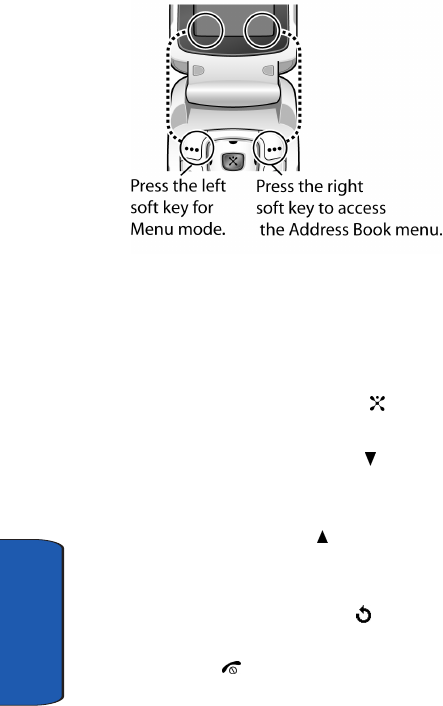
26
Section 3
Selecting Options
To view the various functions and options available and
to select the one you want:
1. Press the appropriate soft key.
2. To select the function displayed or the option highlighted,
press the Select soft key or the key.
3. To view the next function or highlight the next option on a
list, press the Down key or the key on the left side of
the phone.
4. To move back to the previous function or option on a list,
press the Up key or the key on the left side of the
phone.
5. To move back up one level in the menu structure, press
the Left Navigation key or the key.
6. To exit the menu structure without changing the settings,
press the key.
x497.book Page 26 Wednesday, March 30, 2005 5:22 PM

Section 3: Call Functions 27
Silent Mode
Section 3
In some functions, you may be asked for a password or
PIN. Enter the code and press the OK soft key or the
key.
When you access a list of options, your phone highlights
the currently active option. If, however, there are only two
options, such as On/Off or Enable/Disable, your phone
highlights the option that is not currently active, so that
you can select it directly.
Options During a Call
Your phone provides a number of control functions that
you can use during a call.
Putting a Call on Hold
You can place the current call on hold whenever you want.
You can make another call while you have a call in
progress if your network supports this service.
To place a call on hold, simply press the Hold soft key. You
can reactivate the call whenever you want, by pressing the
Resume soft key.
To make a call while you have a call in progress:
1. Enter the phone number that you wish to dial or look it up
in the Address Book.
2. Press the key to dial the second call.
The first call is automatically put on hold.
Or
1. Put the current call on hold by pressing the Hold soft
key.
2. Make the second call in the normal way.
x497.book Page 27 Wednesday, March 30, 2005 5:22 PM

28
Section 3
When you have an activate call and a call in hold, you may
switch between the two calls, changing the one on hold to
activate and placing the other on hold.
To switch between the two calls, simply press the Swap
soft key.
The current call is placed on hold and the call on hold is
reactivated so that you can continue conversing with that
person.
When you want to finish, end each call normally by
pressing the key.
Switching off the Microphone (Mute)
You can temporarily switch your phone’s microphone off,
so that the other person cannot hear you.
Example: You wish to say something to person in the room, but do not
want the person on the phone to hear you.
To switch the microphone off temporarily:
1. Press the Options soft key or the key.
2. If necessary, press the Down key to highlight the Mute
option.
3. Press the Select soft key or the key. The other person
can no longer hear you.
To switch the microphone back on:
1. Press the Options soft key or the key.
2. If necessary, press the Down key to highlight the
Unmute option.
x497.book Page 28 Wednesday, March 30, 2005 5:22 PM

Section 3: Call Functions 29
Silent Mode
Section 3
3. Press the Select soft key or the key. The other person
can hear you again.
Muting or Sending Key Tones
These options allow you to turn the key tones off or on. If
the Mute keys option is selected, your phone does not
transmit the DTMF (Dual Tone Multi-Frequency) tones of
the keys, which allows you to press keys without hearing
annoying key tones during a call.
Note: To communicate with answering machines or computerized
telephone systems, the Send keys option must be selected.
Searching for a Number in Address Book
You can search for a number in Address Book during a
call.
1. Press the Options soft key or the key.
2. Press the Down key to highlight the Address Book
option.
3. Press the OK soft key or the key.
The Phone book entries are listed.
4. Enter the name that you wish to find.
5. If you enter the first few letters of the name, the Phone
book entries are listed starting with the first entry
matching your input.
6. To view the highlighted entry, press the View soft key or
the key.
For further details about the Phone book feature, see
"Finding a Phone Book Entry" on page 52.
x497.book Page 29 Wednesday, March 30, 2005 5:22 PM

30
Section 3
Call Waiting
You can answer an incoming call while you have a call in
progress, if this service is supported by the network and
you have set the Call waiting menu to Activate. You are
notified of an incoming call by a call waiting tone.
To answer a call while you have a call in progress:
1. Press the key to answer the incoming call. The first
call is automatically put on hold.
2. To switch between the two calls, press the Swap soft
key.
To end a call on hold, press the Options soft key or the
key and select the End held call option.
To end the current call, press the key.
Making a Multi-Party Call
A multi-party call is a network service that allows up to six
people to take part simultaneously in a multi-party or
conference call.
For further details about subscribing to this service,
contact your service provider.
Setting up a Multi-Party Call
1. Call the first participant in the normal way.
2. Call the second participant in the normal way. The first
call is automatically put on hold.
3. To join the first participant to the multi-party call, press
the Options soft key or the key and select Join.
Press the OK soft key or the key.
x497.book Page 30 Wednesday, March 30, 2005 5:22 PM

Section 3: Call Functions 31
Silent Mode
Section 3
4. To add a new person to the multi-party call, call the new
person in the normal way and then press the Options
soft key or the key. Select the Join option and press
the OK soft key or the key.
You can add incoming callers by answering the call and
pressing the Options soft key or the key, and selecting
Join. Repeat as required.
Having a Private Conversation With One Participant
1. Press the Options soft key or the key and choose the
Select one option. Press the OK soft key or the key.
The list of call participants appears.
2. Highlight a person by pressing the Up or Down key, and
press the Select soft key, the key, or the key.
3. When the Private option highlights, press the OK soft
key or the key.
Now you can talk privately to that person. The other
participants can continue to converse with each other.
4. To return to the multi-party call, press the Options soft
key or the key and select Conference. Press the OK
soft key or the key.
All of the multi-party call participants can now hear each
other.
Dropping One Participant
1. Press the Options soft key or the key and choose the
Select one option. Press the OK soft key or the key.
The list of call participants appears.
x497.book Page 31 Wednesday, March 30, 2005 5:22 PM

32
Section 3
2. Highlight a person by pressing the Up or Down key, and
press the Select soft key, the key.
3. Press the Down key to select the Remove option and
press the OK soft key or the key.
The call with that participant ends, but you can continue
to talk to the other participants.
4. When you want to end the multi-party call, close the
phone or press the key.
x497.book Page 32 Wednesday, March 30, 2005 5:22 PM

Section 4
Section 4: Menu Navigation 33
Section 4: Menu Navigation
Topics Covered
• Menu Navigation
• Menu Outline
This section explains the menu navigation for your
phone. It also includes an outline of all the available
menus associated with your phone.
x497.book Page 33 Wednesday, March 30, 2005 5:22 PM

Section 4
34
Menu Navigation
You can tailor the phone’s range of functions to your
needs using menus and sub-menus. Menus and sub-
menus can be accessed by scrolling using the Navigation
keys or by using the shortcuts.
Accessing a Menu Function by Scrolling
1. In Idle mode, press the Menu soft key to access Menu
mode.
2. Scroll using the Navigation keys to reach a main menu
Settings for example. Press the Select soft key or the
key to enter the menu.
3. Select Phone Settings and press the Select soft key or
the key.
4. If the menu contains sub-menus, Language for
example, you can access them by pressing the Select
soft key or the key.
If the menu that you have selected contains further
options, repeat this step.
5. To scroll through the menus, press the Up or Down key
or the Volume keys.
6. To confirm the chosen setting, press the Select soft key,
or the key.
7. To return to the previous menu level, press the key,
the key or the Left Navigation key.
8. To exit the menu without changing the settings, press the
key.
x497.book Page 34 Wednesday, March 30, 2005 5:22 PM

Section 4: Menu Navigation 35
Menu Outline
Section 4
Using Shortcuts
The menu items, such as menus, sub-menus, and options,
are numbered and can be accessed quickly by using their
shortcut numbers. For the main menus, you can access
any one of them by pressing the number keys (1 to 0)
corresponding to their location on the screen.
Example: Accessing the Language menu.
1. Press the Menu soft key.
2. Press the 9 key for Settings.
3. Press the 2 key for Phone Settings.
4. Press the 6 key for Language.
The languages available display.
Menu Outline
The following list shows the menu structure and indicates
the number assigned to each option.
1. Voice messages
2. Call records
2.1 Missed calls
2.2 Incoming calls
2.3 Outgoing calls
2.4 Delete all
2.5 Call time
2.5.1 Last call
2.5.2 Total outgoing
x497.book Page 35 Wednesday, March 30, 2005 5:22 PM

Section 4
36
2.5.3 Total incoming
2.5.4 Reset timers
3. t-zones
3.1 Home
3.2 Favorites
3.3 Go to URL
3.4 Clear cache
4. IM
5. Messages
5.1 Text messages
5.1.1 Create
5.1.2 Inbox
5.1.3 Outbox
5.1.4 Delete all
5.2 Picture messages
5.2.1 Create
5.2.2 Inbox
5.2.3 Outbox
5.2.4 Draft
5.2.5 Delete all
5.3 Browser messages
5.3.1 Inbox
5.3.2 Receive
x497.book Page 36 Wednesday, March 30, 2005 5:22 PM

Section 4: Menu Navigation 37
Menu Outline
Section 4
5.3.3 Delete all
5.4 Voice mail
5.4.1 Call voice mail
5.4.2 Voice server number
5.5 Broadcast messages*
5.6 Settings
5.6.1 Text messages
5.6.2 Picture messages
5.7 Memory status
5.7.1 Text messages
5.7.2 Picture messages
6. Funbox
6.1 t-zones
6.2 Sounds
6.3 Images
6.4 Games
6.5 My photos
6.6 Delete all
6.7 Memory status
7. Organizer
7.1 Alarm
7.2 Calendar
7.3 Calculator
x497.book Page 37 Wednesday, March 30, 2005 5:22 PM

Section 4
38
7.4 To do list
7.5 Voice memo
7.5.1 Record voice
7.5.2 Voice memos
7.5.3 Delete all
7.5.4 Settings
7.5.5 Memory status
7.6 Conversion
7.7 Timer
7.8 Stopwatch
8. Camera
8.1 Take and Send
8.2 My Photos
8.3 My Album
8.4 My Journal
8.5 Delete all
8.6 Settings
8.6.1 Photo size
8.6.2 Shutter sound
8.6.3 Default name
8.7 Memory status
9. Settings
9.1 Time & Date
9.1.1 Set date
x497.book Page 38 Wednesday, March 30, 2005 5:22 PM

Section 4: Menu Navigation 39
Menu Outline
Section 4
9.1.2 World time
9.1.3 Set time
9.1.4 Time format
9.1.5 Auto update
9.2 Display settings
9.2.1 Wallpaper
9.2.2 Interior display
9.2.3 Backlight
9.2.4 Brightness control
9.2.5 Service light
9.3 Sound Settings
9.3.1 My MegaTones
9.3.2 Get More MegaTones
9.3.3 Ringtones
9.3.4 Ring volume
9.3.5 Alert type
9.3.6 Keypad tone
9.3.7 Message tone
9.3.8 Power on/off
9.3.9 Alerts on call
9.3.10 Extra tones
9.4 Get More Help
9.5 Greeting message
x497.book Page 39 Wednesday, March 30, 2005 5:22 PM

Section 4
40
9.6 Language
9.7 Security
9.7.1 PIN check
9.7.2 Change PIN
9.7.3 Phone lock
9.7.4 Change password
9.7.5 Privacy
9.7.6 SIM lock
9.7.7 FDN mode
9.7.8 Change PIN2
9.8 Extra settings
9.9 Reset settings
9.10 Network services
9.10.1 Call forwarding
9.10.2 Call waiting
9.10.3 Network selection
9.10.4 Caller ID
9.10.5 Band selection
* Shows only if supported by your SIM card.
x497.book Page 40 Wednesday, March 30, 2005 5:22 PM

Section 4: Menu Navigation 41
Menu Outline
Section 4
x497.book Page 41 Wednesday, March 30, 2005 5:22 PM

Section 4
42
x497.book Page 42 Wednesday, March 30, 2005 5:22 PM

Section 5: Entering Text 43
Section 5
Section 5: Entering Text
Topics Covered
• Changing the Text Input Mode
• Using T9 Mode
• Using Alphabet Mode
• Using Symbols
• Using Numbers
This section outlines how to select the desired text input
mode when entering characters into your phone. This
section also describes how to use the T9 predictive text
entry system to reduce the amount of key strokes
associated with entering text.
x497.book Page 43 Wednesday, March 30, 2005 5:22 PM

44
Section 5
Changing the Text Entry Mode
When using your phone, you will often need to enter text,
such as when storing a name in the Address Book,
creating your personal greeting or scheduling events on
your calendar. You can enter alphanumeric characters by
using your phone’s keypad.
Your phone has the following text input modes:
ABC mode
This mode allows you to enter letters by pressing the key
labeled with the letter you want. Press the key once, twice,
three, or four times until it displays.
T9 mode
This mode allows you to enter words with only one
keystroke per letter. Each key on the keypad has more
than one letter; for example, pressing the 5 key can enter
J, K, or L. However, the T9 mode automatically compares
the series of keystrokes you make with an internal
linguistic dictionary to determine the most likely word,
thus requiring far fewer keystrokes than the traditional
Alphabet mode.
Symbol mode
This mode allows you to enter symbols, such as
punctuation marks.
Number mode
This mode allows you to enter numbers.
x497.book Page 44 Wednesday, March 30, 2005 5:22 PM
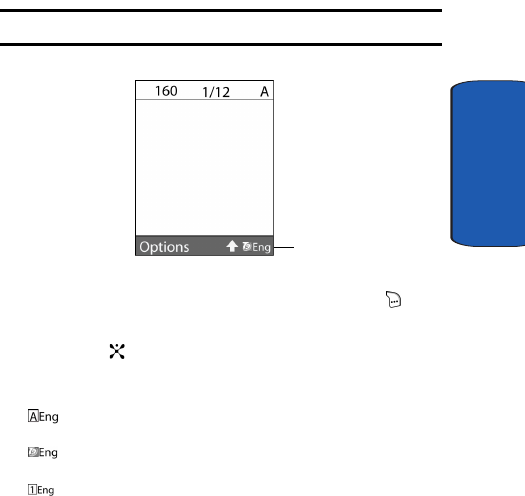
Section 5: Entering Text 45
Changing the Text Entry Mode
Section 5
Changing the Text Input Mode
When you are in a field that allows characters to be
entered, you will notice the text input mode indicator on
the display.
Example: Writing a text message.
1. To select change the text input mode, press the key.
2. Highlight the input option, and press the Select soft key
or the key.
3. Choose from the following options:
: ABC mode
: T9 mode
: Number mode
Text input mode
indicator
x497.book Page 45 Wednesday, March 30, 2005 5:22 PM

46
Section 5
Using T9 Mode
T9 is a predictive text input mode that allows you to key
in any character using single keystrokes. This text input
mode is based on a built-in dictionary.
To enter a word in T9 mode:
1. When you are in T9 mode, start entering a word by
pressing the 2 to 9 keys. Press each key only once for
each letter.
Example: To enter “Hello” in T9 mode, press the 4, 3, 5, 5, and 6
keys.
The word that you are typing appears on the display. It
may change with each key that you press.
2. Enter the whole word before editing or deleting the
keystrokes.
3. When the word displays correctly, go to step 4.
If the word doesn’t display correctly, press the 0 key or
the Up or Down key to display alternative word choices
for the keys that you have pressed.
Example: Both “Of” and “Me” have the 6 and 3 keys. The phone displays
the most commonly used choice first.
4. Insert a space by pressing the key and start entering
the next word.
To add a new word into the T9 dictionary:
1. After pressing the keys corresponding to the word you
want to add, press the 0 key or the Up or Down key to
x497.book Page 46 Wednesday, March 30, 2005 5:22 PM

Section 5: Entering Text 47
Using Alphabet Mode
Section 5
display the alternative words.
2. When you press the 0 key or the Up or Down key at the
last alternative word, the display shows Add on the
bottom line. Press the Spell soft key or the key.
3. If necessary, clear the word using the C key and enter
the word you want to add using ABC mode. See page
"Changing the Text Entry Mode" on page 44.
4. Press the OK soft key or the key.
The word is added to the T9 dictionary and becomes the
first word for the associated keypress series.
Note: This feature may not be available for some languages.
• To enter periods, hyphens, or apostrophes, press the 1 key. T9
mode applies grammar rules to ensure that correct
punctuation is used.
• To shift case in T9 mode, use the key. There are 3 cases:
Initial capital, Capital lock, and Lower case.
• You can move the cursor by using the Left and Right keys. To
delete letters, press the C key. Press and hold the C key to clear
the display.
Using Alphabet Mode
To use the Alphabet Mode use the 2 to 9 keys to enter your
text.
1. Press the key labeled with the letter you want:
ⅷ- Once for the first letter
ⅷ- Twice for the second letter
ⅷ- And so on
x497.book Page 47 Wednesday, March 30, 2005 5:22 PM
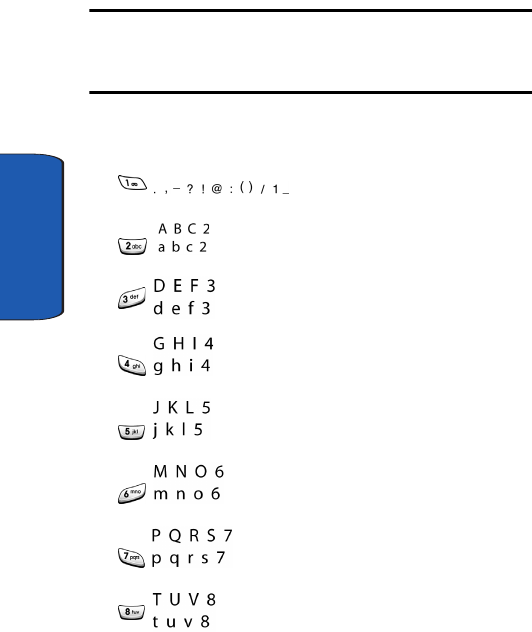
48
Section 5
2. Select the other letters in the same way.
Note: The cursor moves to the right when you press a different key. When
entering the same letter twice or a different letter on the same key, just
wait for a few seconds for the cursor to move to the right automatically,
and then select the next letter.
Keys
x497.book Page 48 Wednesday, March 30, 2005 5:22 PM

Section 5: Entering Text 49
Entering Symbols
Section 5
Entering Symbols
Symbol mode allows you to enter symbols by pressing the
key labeled with the letter you want. When in a text
message screen, press the soft key to access the Symbol
mode. The Symbol screen displays the available symbols
for each key. Use the Up or Down Navigation keys to
cycle through all available symbols.
1. To select a symbol, press the corresponding number
key.
2. To display more symbols, press the Up or Down
Navigation key.
3. To clear the symbol(s), press the C key. When the input
field is empty, this key returns the display to the previous
mode.
4. To insert the symbol(s) into your message, press the OK
soft key or the key.
Using Numbers
Number mode allows you to enter numbers by pressing
the key labeled with the number you want. When in a text
message screen, press the soft key to access the
Number mode.
x497.book Page 49 Wednesday, March 30, 2005 5:22 PM

50
Section 5
x497.book Page 50 Wednesday, March 30, 2005 5:22 PM

Section 6: Understanding Your Address Book 51
Section 6
Section 6: Understanding Your Address
Book
Topics Covered
• Finding a Address Book Entry
• Adding a New Address Book Entry
• Using Address Book Entry Options
• Dialing a Number from Address Book
• Dialing a Number from SIM Card
• Storing a Number Using the Address Book Menu
• Speed Dialing
• Deleting all of the Address Book Entries
• Editing an Existing Address Book Entry
• Checking the Memory Status
• Finding My Address Number
This section allows you to manage your daily contacts by
storing their name and number in your Address Book.
Address Book entries can be sorted by name, entry, or
group.
x497.book Page 51 Wednesday, March 30, 2005 5:22 PM

52
Section 6
Finding a Address Book Entry
You can store phone numbers and their corresponding
names in your SIM card and phone’s memories. They are
physically separate but are used as a single entity, called
Address Book.
Depending on your particular SIM card, the maximum
number of phone numbers the SIM card can store may
differ.
1. Press the Menu soft key and select Address Book.
2. Press the Select soft key or the key when Search
highlights. You are asked to enter a name.
3. Enter the first few letters of the name.
The Address Book entries are listed, starting with the
first entry matching your input.
4. To view the highlighted entry, press the OK soft key.
5. Press the key to dial the number, or press the
Options soft key to access the Address Book entry
options.
Storing a Number to the Phone’s Memory
1. Press the Menu soft key and select Address Book.
2. Scroll to New entry by pressing the Up or Down key and
press the Select soft key or the key.
3. Enter a number you want to store and press the Save
soft key or the key.
4. Select the Phone memory location by pressing the Up or
Down key and press the Select soft key or the key.
x497.book Page 52 Wednesday, March 30, 2005 5:22 PM

Section 6: Understanding Your Address Book 53
Storing a Number to the SIM Memory
Section 6
5. Select a category of the number to be stored by pressing
the Up or Down key, and press the Select soft key or the
key.
6. Enter a name and press the OK soft key or the key.
For further details about how to enter characters, see
"Create" on page 66.
After storing, the phone displays the Address Book entry
or name you just created
7. To use the entry options, press the Options soft key. For
more information see, "Using Address Book Entry
Options" on page 54.
8. Tab through the options to assign the Address Book entry
Group, Image, and Ringtone settings.
9. To return to the Idle screen, press the key.
Storing a Number to the SIM Memory
1. Press the Menu soft key and select Address Book.
2. Scroll to New entry by pressing the Up or Down key
and press the Select soft key or the key.
3. Enter a number you want to store and press the Save
soft key or the key.
4. Select the SIM memory location, by pressing the Up or
Down key and press the Select soft key or the key.
5. Enter a name and press the OK soft key or the key.
For further details about how to enter characters, see
"Create" on page 66.
x497.book Page 53 Wednesday, March 30, 2005 5:22 PM

54
Section 6
After storing, the phone displays the Address Book entry
number you just created
6. To use the entry options, press the Options soft key. For
more information see, “Using Address book Entry
Options”.
7. To return to the Idle screen, press the key.
Using Address Book Entry Options
While accessing any Address Book entry, press the
Options soft key to use the options for the entry.
The following options are available:
Edit Number: allows you to edit the number.
Change Name: allows you to edit the name.
Send Message: allows you to send a message to the
selected number.
Copy: allows you to copy the number to another location.
You can select the memory location, either SIM or Phone,
and the location number.
Delete Entry: allows you to delete the name and number
from Address Book. You are asked to confirm that you
wish to delete the name and number by pressing the Yes
soft key.
Speed Dialing
Once you have stored phone numbers from your Address
Book list, you can set up to 8 speed dial entries and then
dial them easily whenever you want, simply by pressing
the associated numeric key.
x497.book Page 54 Wednesday, March 30, 2005 5:22 PM

Section 6: Understanding Your Address Book 55
Dialing a Number from Address Book
Section 6
Setting Up Speed Dial Entries
1. When the Idle screen displays, press the Menu soft key.
Highlight Address Book and press the Select soft key or
the key.
2. Scroll to Speed Dial by pressing the Up or Down key
and press the Select soft key or the key.
3. Select the key to which you wish to assign the speed-
dialing number, from the 2 to 9 keys, and press the
Select soft key or the key.
Note: Memory location 1 is reserved for your Voice mail server number.
4. Highlight Edit Number and press the Select soft key or
the key. Enter a number or press the Names soft key
to display entries in the Address Book.
5. Select an entry from the Address Book list and press the
OK soft key or the key.
6. Press the OK soft key or the key.
Dialing a Number from Address Book
Once you have stored phone numbers in the Address
Book, you can dial them easily and quickly by using the
location numbers that were assigned to them in the
Address Book.
Note: If you cannot remember a location number, you must go into the
Search menu in the Address Book menu to search for the entry by name.
For details, "Finding a Address Book Entry" on page 52.
x497.book Page 55 Wednesday, March 30, 2005 5:22 PM

56
Section 6
Dialing a Number from the SIM Card
1. In Idle mode, enter the location number for the phone
number you want to dial and press the key.
The list of entries in the SIM card appears, with the
desired number highlighted.
2. You can press the Up or Down key to find other numbers
on the list.
3. Press the Dial soft key, the key, or the key when
you have selected the number you want.
Delete All
You can delete all your entries from your phone’s
memory, your SIM card, or both.
1. When the Idle screen displays, press the Menu soft key.
Highlight Address Book and press the Select soft key or
the key.
2. Scroll to Delete all by pressing the Up or Down key and
press the Select soft key or the key.
3. To place a check mark by the memory location you want
to empty, All, SIM, or Phone, press the Select soft key or
the key.
You can remove the check mark by pressing the Select
soft key or the key.
4. Press the OK soft key to delete the entries in the selected
memory location. A confirmation “Sure to Delete”
displays. Press Yes to delete or No to cancel.
5. Enter the phone password and press the OK soft key or
the key.
x497.book Page 56 Wednesday, March 30, 2005 5:22 PM

Section 6: Understanding Your Address Book 57
Own Number
Section 6
Note: The password is preset to “00000000” at the factory. To change this
password, see page "Change Password" on page 98.
6. When you are finished, press the C key or the key.
Own Number
This function is a memory aid, which you can use to check
your own phone number if you need to do so.
You can assign a name to each of your own phone
numbers registered on your SIM card. You can also edit
the names and numbers. Any changes made here do not
in any affect the actual subscriber numbers on your SIM
card.
1. When the Idle screen displays, press the Menu soft key.
Highlight Address Book and press the Select soft key or
the key.
2. Select the Own Number option by pressing the Up or
Down key and press the Select soft key or the key.
3. Highlight Edit Number and press the Select soft key or
the key. Enter the phone number you want and press
the OK soft key or the key.
4. Highlight Change Name and press the Select soft key
or the key. Enter the name and press the OK soft key
or the key.
5. Highlight Delete and press the Select soft key or the
key. Select Yes to confirm deletion or No to cancel.
x497.book Page 57 Wednesday, March 30, 2005 5:22 PM

58
Section 6
Group Setting
1. When the Idle screen displays, press the Menu soft key.
Highlight Address Book and press the Select soft key or
the key.
2. Scroll to Group Setting by pressing the Up or Down key
and press the Select soft key or the key.
3. Scroll through the group list by pressing the Up or Down
key.
4. When the group you want highlights, press the Select
soft key or the key.
5. Select each option and change the settings, as required.
The following options are available:
Ring tone: allows you to set the ring tone to be used when
you receive a voice call from a member of that group.
Change Name: allows you to rename the selected group
setting.
View Image: allows you to view the graphic displayed
when you receive a voice call from a member of that
group.
6. When you are finished, press the C key or the key.
Memory Status
You can check how many names and numbers are stored
in Address Book, in both SIM card and the phone memory.
You can also see the capacity of both memories.
1. When the Idle screen displays, press the Menu soft key.
Highlight Address Book and press the Select soft key or
the key.
x497.book Page 58 Wednesday, March 30, 2005 5:22 PM

Section 6: Understanding Your Address Book 59
Service Dialing Number
Section 6
2. Select the Memory status option by pressing the Up or
Down key and press the Select soft key or the key.
3. Displayed are the total numbers stored in the Phone and
SIM.
4. When you are finished, press the soft key or the
key.
Service Dialing Number
You can view the list of Service Dialing Numbers (SDN)
assigned by your service provider. These numbers
include emergency numbers, directory enquiries and
voice mail numbers.
1. When the Idle screen displays, press the Menu soft key.
Highlight Address Book and press the Select soft key or
the key.
2. Select the Service Number option by pressing the Up or
Down key and press the Select soft key or the key.
3. Scroll through the numbers by using the Up or Down
key.
4. To dial the number displayed, press the Select soft key
or the key.
Note: This menu is available only when your SIM card supports Service
Dialing Numbers.
x497.book Page 59 Wednesday, March 30, 2005 5:22 PM

60
Section 6
x497.book Page 60 Wednesday, March 30, 2005 5:22 PM

Section 7: Messaging 61
Section 7
Section 7: Messaging
Topics Covered
• Types of Messages
• Message Alerts
• Retrieving New Messages
•Voicemail
• Deleting Messages
• Clearing the Message Icon
This section allows you to send or receive different types
of messages. It also includes the features and functionality
associated with messaging.
x497.book Page 61 Wednesday, March 30, 2005 5:22 PM

62
Section 7
Using Instant Messenger
Instant Messenger (IM) is a way of sending short, simple
messages that are delivered immediately to users online
at the moment.
Before using this feature, you need to subscribe to a
messenger service. For further details, contact our service
provider.
Note: Your phone is set to use your service provider’s messenger service
by default. You can change the configurations for Instant Messenger, such
as the default community or auto sign on.
Start Your Messenger
Note: The p207 handset supports the following Instant Messaging
Applications: AIM, ICQ, and Yahoo.
1. In Idle mode, press the Menu soft key to access Menu
mode.
2. Select Messaging and then highlight IM and press the
Select soft key or the key.
3. Highlight your established IM application and press the
Select soft key or the key.
4. Select Sign On and press the Select soft key or the
key.
5. Enter your Logon ID (this field title will change reflect the
name used in each instant message application) and
your Password and press the OK soft key.
x497.book Page 62 Wednesday, March 30, 2005 5:22 PM

Section 7: Messaging 63
Creating and Sending New Messages
Section 7
Note: Use the Down Navigation key to the Auto-Sign On option and press
the . Press the OK soft key to continue.
6. Press the Options soft key and select Buddy List. The
subscribers of the messenger service displays.
7. Select the person you want to talk to.
8. Start the conversation with the person as you would on a
normal messenger for a PC.
9. When you want to end the conversation, press the
Options soft key and select Sign Off.
Viewing the Conversation Log
You can view the log of your conversations in the Instant
messenger Conversation log.
Online or offline, press the Options soft key and select
Conversation Log.
Creating and Sending New Messages
This section guides you through the procedure to send
various types of messages.
Creating and Sending a Simple Text Message
1. In Idle mode, press the Menu soft key to access Menu
mode.
2. Select Messaging. Highlight Create New Message and
press the Select soft key or the key.
3. Highlight Text Message and press the Select soft key or
the key. The Write New screen appears.
x497.book Page 63 Wednesday, March 30, 2005 5:22 PM

64
Section 7
Note: Use the key to change text input settings.
4. Create your message.
5. When you have finished writing the message, press the
Options soft key. Choose from the following options:
ⅷSend to Number: allows you to select from Save and Send or
Send Only to the specified number.
ⅷSend to Email: allows you to Save and Send or Send only to the
specified email address.
6. Select Send Only to send the message. Continue to the
next step.
Alternatively, select Save and Send to save the message
in the Sent folder.
Note: For details about using other options, see the next page.
7. Choose from Add Address Book or Add Group or enter
a destination number. If you want to send the message to
multiple destinations, press the OK soft key after
entering a number and repeat this step.
8. When you have finished entering destination numbers,
press the key or the key.
Creating and Sending on Enhanced Text Message
1. In Idle mode, press the Menu soft key to access Menu
mode.
2. Select Messaging. Highlight Create New Message and
press the Select soft key or the key.
x497.book Page 64 Wednesday, March 30, 2005 5:22 PM

Section 7: Messaging 65
Creating and Sending New Messages
Section 7
3. Highlight Text Message and press the Select soft key or
the key. The Write New screen appears.
4. Create your message.
5. While entering the message text, press the Options soft
key to access the following options to enhance your
message:
Note: When you add media items to a message, the number of characters
you can enter decreases.
ⅷSend to Number: allows you to select from Save and Send or
Send Only to the specified number.
ⅷSend to Email: allows you to Save and Send or Send only to the
specified email address.
ⅷInsert: allows you to add text from the Templates folder, an
entry in Address Book, or a URL address in the Favorites folder.
ⅷAdd Media: allows you to add one from various default media
items, such as Pictures, Animations, Melodies and Downloads.
ⅷAttach: you can add entries from the Name Card (vCard) and
an vEvent or vTodo from the Calendar (vCalendar).
ⅷSave Message to: allows you to save the message to Draft or to
My Folder.
ⅷLanguage Select: allows you to change the language to be
used in T9 input mode.
ⅷText Style: allows you to format the style of the text.
For the Size attribute, Medium, Large, and Small sizes are
available. For the Bold , Italic, Underline and Strike throughs
attributes, select Off or On.
6. Complete the message, and send or save it by following
the procedure from "Creating and Sending a Simple Text
Message" on page 63.
x497.book Page 65 Wednesday, March 30, 2005 5:22 PM

66
Section 7
Creating a Long Text Message
When you write a text message, the phone automatically
splits it into several messages if your message exceeds the
maximum number of characters allowed for sending. The
number of split messages to be sent is shown each time
your message is split. Depending on your service
provider, the maximum number of characters may vary.
Creating and Sending an Multimedia Message
1. In Idle mode, press the Menu soft key to access Menu
mode.
2. Select Messaging. Highlight Create New Message and
press the Select soft key or the key.
3. Highlight Multimedia Message and press the Select
soft key or the key.
4. When Add Here highlights, press the Options soft key
and add the message contents using one of the following
options:
ⅷAdd Text: enter the message text and press the key. While
entering text, you can add a message template or an entry in
Address Book, or change the input language by pressing the
Options soft key.
ⅷAdd Graphic: allows you to add an image or photo. You can
take a new photo or add one of the photos stored in the
phone’s memory.
Select Take Photo to take a new photo, or Photo Album to add
one of the photos stored in the phone’s memory, or Downloads
to add one of the graphics stored in your graphics folder. For
further details about using the camera, see "Using the
Camera" on page 134.
x497.book Page 66 Wednesday, March 30, 2005 5:22 PM

Section 7: Messaging 67
Creating a Long Text Message
Section 7
ⅷAdd Video: allows you to add a video clip. You can record a new
video clip or add one of video clips stored in the phone’s
memory.
Select Record Video to take a new video, or Video Album to add
one of the video’s stored in the phone’s memory, or Downloads
to add one of the videos stored in your video folder. For further
details about using the camera, see "Using the Camera" on
page 134.
ⅷAdd Audio: allows you to add a sound file. You can record a
new audio clip or add an existing audio clip, or select one of
sound clips stored in the Audio folder.
Select Record Audio to record a new voice memo or Audio List
to add one of the voice memos or sound clips stored in the
phone’s memory. You can add Downloaded sounds if they are
in correct format and your service provider supports them.
ⅷAdd Subject: allows you to enter text for the subject.
ⅷSend: allows you to send the message.
ⅷSave to: saves the message to Draft or My Folder.
ⅷSettings: allows you to change the message settings. After
changing the settings, press the soft key or the key to
go back to the message screen.
ⅷAdd Destination: allows you to enter destination numbers or
addresses. After adding them, press the key or the
key to go back to the message screen.
ⅷPreview: shows the message you created.
Note: You can add text, an image, and a sound only once for each page.
5. If you need to add another page for additional
information, use the Up or Down Navigation keys to
highlight Page 1/x. Press the Options soft key and
select Add Page.
x497.book Page 67 Wednesday, March 30, 2005 5:22 PM

68
Section 7
6. Repeat step 4 until you have finished creating your
message.
7. If you want to change the added items, scroll to the one
you want and press the Options soft key or key.
8. When you have finished creating the message, press the
Options soft key and choose Send.
9. Select a destination type, To, Cc, or Bcc.
10.Choose one of the following options:
ⅷPhone Number: allows you to enter the phone number you
want.
ⅷEmail Address: allows you to enter the email address of the
recipient.
ⅷAddress Book: allows you to retrieve a number from your
Address Book.
11.Enter a Phone Number or an Email Address, or select a
number from the Address Book.
12.When the correct number or address displays, press the
OK soft key or the key.
13.To add a destination, select Add Destination and repeat
from step 9.
If you want to edit the destinations, select the one you
want. You can change or delete it.
14.To enter additional numbers or addresses to the other
destination types, press the key or the soft key
and repeat steps 8 through 12.
You can enter up to 10 destination search to To, CC, and
Bcc.
x497.book Page 68 Wednesday, March 30, 2005 5:22 PM

Section 7: Messaging 69
Creating a Long Text Message
Section 7
15.When you have finished entering the destinations, select
Send Message. Your phone sends the message.
Creating and Sending an Email
1. In Idle mode, press the Menu soft key to access Menu
mode.
2. Select Messaging. Highlight Create New Message and
press the Select soft key or the key.
3. Highlight Email and press the Select soft key or the
key.
4. Enter the subject of your email and press the OK soft key
or the key.
5. Enter the email text and press the Options soft key.
6. Select Add Attachments and the following options are
available:
ⅷAdd vCard: allows you to attach a vCard from your Address
Book to the email.
ⅷAdd vCalendar: allows you to attach the a memo from the
Personal Organizer.
ⅷAdd Graphic: allows you to add attach a photo recently taken,
or from your Photo Album, or an attachment stored in the
Downloads folder.
ⅷAdd Video: allows you to add a video recently taken, from your
Video Album, or an attachment stored in the Downloads folder.
ⅷAdd Audio: allows you to add a Voice Memo you’ve recorded
or previously recorded audio stored in the Audio List, or audio
stored in the Downloads folder.
After selecting the file type you want to add, choose an item
from the list. You can add up to 9 items. After adding, press
the soft key or the key to go back to the email screen.
x497.book Page 69 Wednesday, March 30, 2005 5:22 PM

70
Section 7
ⅷView Attachment: allows you to view the information included
in the email attachment .
If you want to remove an attached item, select Attachment
View soft key and then the Discard soft key.
7. Select Insert to add a message text from the Text
Templates folder, an entry in Address Book, or a URL
address in the Favorites folder.
8. Select Language to change the language to be used in
T9 input mode.
9. Select Send Only to send the email.
10.Select Save and send to save the email to the Sent
folder and also sends it to the recipient.
11.Select Save to to save the email the Draft or My folder.
12.Select Add Destination to allow you to add destination
addresses. After adding, press the soft key or key
to go back to the email screen.
Select a destination type To, Cc, or Bcc.
13.Select Properties to show the email subject, the list of
the recipients you added, if any, and message text.
14.To add more addresses, select To, Cc, or Bcc.
15.Choose one of the following options:
ⅷDirect Enter: allows you to directly enter the email address you
want.
ⅷAddress Book: allows you to retrieve an email address from
your Address Book.
16.When there is an email address already entered in the
selected destination type, select Add Destination.
x497.book Page 70 Wednesday, March 30, 2005 5:22 PM

Section 7: Messaging 71
Creating a Long Text Message
Section 7
17.When you are finished adding the destinations, select
Send Email. Your phone sends the email.
Using Message Templates
Your phone has message templates to allow you to
retrieve them when creating a message. You can change
the templates as your preferences or send a message
immediately.
1. In Idle mode, press the Menu soft key to access Menu
mode.
2. Select Messaging. Highlight Templates and press the
Select soft key or the key.
3. Select a template and press the Options soft key to
access the following options:
ⅷEdit: allows you to change the template.
ⅷSend Message: allows you to send an SMS message using the
template.
ⅷDelete: deletes the template.
ⅷAdd New: allows you to add a frequently used message to the
template list.
4. When you have finished, press the key.
x497.book Page 71 Wednesday, March 30, 2005 5:22 PM

72
Section 7
Retrieving New Messages
While text messages from other phones are delivered
directly to your phone, MMS messages and emails will be
stored in the Inbox of the message server and the server
will alert you to new messages. Therefore you need to
retrieve new messages to your phone and read them on
the phone.
Retrieving an MMS Message
When a new MMS message comes in, the display shows
the MMS Message icon ( ) and a text notification along
with the sender’s number.
1. Press the View soft key or the key to view brief
information about the message, such as the sender’s
number, the message size, and the subject.
If you want to view the message later in the Inbox, press
the Exit soft key.
2. Press the Options soft key or the key to access the
following options:
ⅷRetrieve: retrieves the message from the MMS server.
ⅷDelete: deletes the message.
ⅷMore Information: shows you detailed information about the
message.
3. Select Retrieve.
Your phone retrieves the message contents from the
server and displays it.
4. To scroll through the message, press the Up or Down
key.
5. When you have finished, press the key.
x497.book Page 72 Wednesday, March 30, 2005 5:22 PM

Section 7: Messaging 73
Viewing Messages
Section 7
Retrieving an Email
When a new email comes in, the display shows the Email
icon ( ) and a text notification.
1. Press the View soft key or the key to view email
information.
2. Press the Options soft key and select Retrieve.
Your phone retrieves the new emails from the server and
displays them on the Inbox list.
3. To read an email, select it on the list.
4. When you have finished, press the key.
Viewing Messages
The My Messages screen provides 6 message folders:
ⅷInbox: stores incoming SMS, MMS, CB, and WAP message
ⅷEmail Inbox: stores incoming emails.
ⅷSent: stores the messages your phone successfully have sent.
ⅷOutbox: stores the messages and emails your phone is
attempting to send temporarily.
ⅷDraft: stores the messages and emails you have saved without
sending or tried to send.
ⅷMy Folders: allows you to create a folder that is used to store
messages. You can create up to 5 message folders to manage
your messages and emails.
Viewing a Message
1. In Idle mode, press the Menu soft key to access Menu
mode.
x497.book Page 73 Wednesday, March 30, 2005 5:22 PM

74
Section 7
2. Select Messaging. Highlight My Messages and select
the message folder. The message list opens.
The icons on the left of the number indicates the
message type
ⅷ: indicates SMS
ⅷ: indicates MMS
ⅷ: indicates email
The icons on the right of the message subject indicate
the memory location and the lock status.
From the message list, you can access the following
options by pressing the Options soft key.
3. Select a message on the list. The message content
displays.
For a Multimedia message, the display presents the
message and then switches to the message view screen.
4. Press the Up or Down key to scroll through the message
screen. For a Multimedia message, press the Left or
Down key to scroll to other pages, if the message has
more than one message.
You can access the message options by pressing the
Options soft key.
ⅷView: allows you to view the message received.
ⅷDelete: deletes the message.
ⅷMove to Myfolder: allows you to move your messages to a
folder you have defined.
ⅷSort by: allows you to sort this message by Date, name,
Subject, Size and Type.
ⅷProtection: allows you to set the protection for a message.
x497.book Page 74 Wednesday, March 30, 2005 5:22 PM

Section 7: Messaging 75
Viewing Messages
Section 7
5. Press the * or # key to scroll to the previous or next
message.
6. When you have finished, press the key.
Using Message Options
While viewing a message, press the Options soft key to
access the following options:
Options for SMS Messages
ⅷReply: allows you to reply to the message received
ⅷForward: allows you to forward the message to another
destination.
ⅷDelete: deletes the currently selected message.
ⅷCallback: allows you to dial the number that the message has
listed.
ⅷMove to Myfolder: allows you to move the message to a
specific folder. You must create a folder in the My Folders
option.
ⅷMove to Phone/SIM : allows you to move the message to the
Phone or SIM card’s memory.
ⅷSave Address: allows you to save the address from which the
message originated.
ⅷSave Media/Attach: allows you to move the attachment to a
specific folder.
ⅷProtection: allows you to set the protection for the message.
Options for Multimedia Messages
ⅷReply: allows you to reply to the destination from which the
message originated. Choose from Reply via Text Message or
Reply via Multimedia Message.
ⅷReply All: allows you to reply to all addresses listed in the
recipient list.
x497.book Page 75 Wednesday, March 30, 2005 5:22 PM

76
Section 7
ⅷForward: allows you to forward the message to another
desitnation. You may Add Subject or simply Send.
ⅷDelete: deletes the message.
ⅷCallback: allows you to dial the number from which the
message was originated.
ⅷMove to Myfolder: allows you to move this sent message to a
folder you have previously created.
ⅷSave Address: allows you to extract the recipient or sender’s
number or address, and URL, email addresses or phone
numbers from the message text so that you can make a call,
send an SMS message, or save them in your phone’s memory.
ⅷSave Contents: allows you to save the Picture, Video, or Sound
from the message received.
ⅷProperties: shows you information about the message.
Options for Email Messages
ⅷReply: allows you to reply to the message.
ⅷForward: allows you to forward the message to other Email
addresses or phone numbers.
ⅷDelete: deletes the message.
ⅷCallback: allows you to call the phone numbers from the
message text.
ⅷMove to Myfolder: allows you to move the message to one of
the folders you have defined.
ⅷMove to Phone/SIM: moves the message to the phone’s
memory or SIM card.
ⅷSave Address: allows you to save the recipient or sender’s
number and URL, Email addresses or phone numbers from the
message text.
ⅷSave Media/Attach: allows you to save media items, such as
sounds or images, from the message into your phone’s
memory. You can then use the items when writing a message.
x497.book Page 76 Wednesday, March 30, 2005 5:22 PM

Section 7: Messaging 77
Viewing Messages
Section 7
ⅷProtection: allows you to lock the message keeping it from
being deleted or unlocks the message.
Managing Your Own Message Folders
You can create up to 5 message folders to store messages
separately from the default message folders.
Creating a Message Folder
1. From the message folder list, press the Options soft key.
2. Select Create Folder.
3. Enter a folder name and press the OK soft key or the
key.
4. When you have finished, press the key.
Moving a Message to a Folder
1. From any message list, select the message you want to
move and press the Options soft key.
2. Select Move to Myfolder.
3. Select one of the folders you have defined. The message
is moved to the folder.
4. When you have finished, press the key.
Renaming a Message Folder
1. In Idle mode, press the Menu soft key to access Menu
mode.
2. Select Messaging. Highlight My Messages and select
the My Folders. The folder list opens.
3. Scroll to the folder you want to rename.
4. Press the Options soft key and select Rename Folder.
5. Clear the current name and enter a new name.
x497.book Page 77 Wednesday, March 30, 2005 5:22 PM

78
Section 7
6. Press the OK soft key or the key.
7. When you have finished, press the key.
Deleting a Message Folder
1. In Idle mode, press the Menu soft key to access Menu
mode.
2. Select Messaging. Highlight My Messages and select
the My Folders. The folder list opens.
3. Scroll to the folder you want to delete.
4. Press the Options soft key and select Delete Folder.
5. Press the Yes soft key or the key to confirm the
deletion.
6. When you have finished, press the key.
Deleting Messages
You can delete the messages in each message folder one by
one or all at one time. You can also delete all of your
messages at one time.
1. In Idle mode, press the Menu soft key to access Menu
mode.
2. Select Messaging. Highlight Delete All and press the
Select soft key or the key.
3. Scroll to the message folder you want to delete and place
a check mark by pressing the key. Repeat this step to
select more message folders.
To delete all of the messages in the folder, select All
Messages.
4. Press the Delete soft key.
x497.book Page 78 Wednesday, March 30, 2005 5:22 PM

Section 7: Messaging 79
Changing Message Settings
Section 7
5. A “Delete All” confirmation message displays. Press the
key to mark the “Include Protection” option. Press the
Yes soft key to confirm the deletion.
6. A message “Are you Sure?” diplays, press the Left soft
key or the key.
7. When you have finished, press the key.
Changing Message Settings
You can set up various options for using messaging
services.
1. In Idle mode, press the Menu soft key to access Menu
mode.
2. Select Messaging and highlight Settings. Press the
Select soft key or the key.
3. Select the type of messages for which you want to
change. Press the Select soft key or the key.
IM
The following options are available:
Default Community: allows you to select the community
you want to join by default.
Profile: allows you to choose the profile information
required to access the instant message utility.
Text Message
The following options are available:
Sending Profile: allows you to set the options for sending
text messages. Choose from the following options:
ⅷSMS Settings
x497.book Page 79 Wednesday, March 30, 2005 5:22 PM

80
Section 7
ⅷEmail Settings
ⅷEmpty
Reply Path: allows the recipient of your message to send
you a reply through your message center, if your network
supports this service.
Delivery Report: allows you to activate or deactivate the
report function. When this function is activated, the
network informs you whether or not your message has
been delivered.
Bearer Selection: allows you to select either GSM or
GPRS, depending on your network.
Preferred Memory (Sent, Outbox, Draft): allows you to
select a default memory where your outgoing or
incoming messages are stored. Choose from In Card or In
Phone.
Multimedia Message
The following options are available:
Delivery Report: when this option is enabled, the
network informs you whether or not your message has
been delivered.
Read Reply: when this option is enabled, your phone
sends a request for a reply along with your message to the
recipient.
Auto Download: you can set whether or not your phone
retrieves new incoming messages from the MMS server
without notifications.
Off: you need to manually download new messages by
using the Retrieve option.
x497.book Page 80 Wednesday, March 30, 2005 5:22 PM

Section 7: Messaging 81
Changing Message Settings
Section 7
On: the phone automatically retrieves new messages
from the server. As soon as you receive a message you can
use more options while you are reading.
Message Acceptance: you can specify the category of
messages you want to receive.
Expiry Date: you can select the length of time your
messages are stored in the message center after they are
sent.
Delivery Time: you can set a time delay before the phone
sends your messages.
Priority: you can select the priority level of your
messages.
Report Allowed: when this option is enabled, the sender
of an incoming message receives a delivery report from
the network.
Page Duration: you can set the length of time one page of
an outgoing message displays on the message
presentation screen. After a specified time, the display
automatically scrolls to the next page.
Profile: you can select a connection profile to be sued for
sending and receiving MMS messages.
Email
The following options are available:
Account: You can configure up to 10 email accounts using
different service providers. The last account you accessed
is automatically activated for sending or receiving email
messages.
For each account, the following options are available:
x497.book Page 81 Wednesday, March 30, 2005 5:22 PM

82
Section 7
ⅷAccount Name: enter a name for the current account.
ⅷDisplay Name: enter the name to be displayed in your outgoing
messages as the sender name.
ⅷEmail Address: enter your email address.
ⅷProtocol Type: specify an email protocol type for the incoming
server, either POP3 or IMAP4. Contact your email service
provider for more information.
Note: For the IMAP4 protocol, you can set whether or not the phone
retrieves emails with attachments. You can also select the number of email
headers you want to retrieve.
ⅷIncoming Server: enter the IP address or domain name of the
server to be used for receiving messages. Your email service
provider can give you this information.
ⅷUser ID: enter your email ID.
ⅷPassword: enter your email password.
ⅷOutgoing Server: enter the IP address or domain name of the
server to be used for sending messages. Your email service
provider can give you this information.
ⅷUse SMTP Auth.: specify a protocol type for the server used.
ⅷReply-to Address: enter the reply to address for email address.
Polling Interval: you can select how often the phone
checks the server for incoming messages.
Signature: you can attach your name, phone number,
simple memo or tag line as a signature to your email.
Send Copy to Self: you can set whether or not your phone
sends a copy of the outgoing email to your email address.
Delivery Report: you can activate or deactivate the report
function. When this function is activated, the network
x497.book Page 82 Wednesday, March 30, 2005 5:22 PM

Section 7: Messaging 83
Changing Message Settings
Section 7
informs you whether or not your email has been
delivered.
Read Reply: you can set whether or not your phone sends
a request for a reply along with your message to the
recipient.
Download Method: you can choose the display of the
email message. You can select Header Only or Normal.
Keep on Server: you can set whether or not your emails
are deleted from the server after retrieval.
Block Email: you can set up the mail filter to block spam
mails. You can enter email address or subject.
Profile: you can select a connection profile to be used for
sending and receiving emails.
Push Message
The following options are available:
Receive: you can select whether the phone receive or
reject push-messages from the WAP server. Choose from
Never, Always, or Only White List.
White List: allows only users on your contact list to push
messages.
Broadcast
The following options are available:
Receive: allows you to enable or disable the reception of
broadcast messages.
Channel List: allows you to indicate the channels from
which you wish to receive broadcast messages. The
following options are available:
x497.book Page 83 Wednesday, March 30, 2005 5:22 PM

84
Section 7
ⅷSelect: use to enable or disable channels on the list by marking
or unmarking them, respectively. A check mark displays in front
of each selected channel.
ⅷAdd Channel: use to enter the ID and title for a new channel.
ⅷDelete: use to remove a channel from the list.
ⅷEdit: use to change the ID and title of an existing channel.
Language: allows you to select your preferred language
in which to display cell broadcast messages.
Please contact your service provider for further details.
Default Text Input Mode
VoiceMode: allows you to set the VoiceMode option as
your default text messages.
Predictive Text Mode: allows you to set the default
setting for text messages to T9.
Alphabet Mode: allows you to set the default setting for
test messages to Alphabet mode.
Checking Memory Status
You can check the memory amount available and
remaining for storing the messages.
1. In Idle mode, press the Menu soft key to access the
Menu mode.
2. Select Messaging. Highlight Memory Status and press
the Select soft key or the key.
3. Select the message type you want.
For Text Message, scroll through the memory. The
displays shows the number of messages you have stored
in the SIM card and memory and the number of
x497.book Page 84 Wednesday, March 30, 2005 5:22 PM

Section 7: Messaging 85
Section 7
messages you have saved in each folder.
For Multimedia Message, Email, and Push Message
the displays show the total memory amount, including
the amount of memory available and used for storing
messages. It also shows the memory amount used for
each message folder.
4. When you have finished, press the key.
x497.book Page 85 Wednesday, March 30, 2005 5:22 PM

86
Section 7
x497.book Page 86 Wednesday, March 30, 2005 5:22 PM

Section 8
Section 8: Changing Your Settings 87
Section 8: Changing Your Settings
Topics Covered
•Time & Date
• Phone Settings
• Display Settings
• Sound Settings
• Network Settings
• Security Settings
• Ringer Settings
• Resetting Your Phone
This section explains the menu navigation for your
phone. It also includes an outline of all the available
menus associated with your phone.
x497.book Page 87 Wednesday, March 30, 2005 5:22 PM

Section 8
88
Time & Date
This menu allows you to change the current time and date
displayed.
1. In Idle mode, press the Menu soft key to access Menu
mode.
2. Select Settings and highlight Time & Date. Press the
Select soft key or the key. Select a menu and then
change the setting. If the menu has submenus, repeat as
necessary.
3. When you have finished, press the key
Set Time
Allows you to enter the current time. You can choose the
time format in the Time format menu.
Set Date
Allows you to enter the month, day, and year. .
Time Format
Allows you to change the time format to 12 hours or
24 hours.
Auto Update
Allows you to receive time information from your service
provider’s network.
• Off: you need to manually set the time and date according to the
current time zone using the Set time menu (Menu 9.1.1).
• On: the phone automatically updates the time and date
according to the current time zone using the network service.
x497.book Page 88 Wednesday, March 30, 2005 5:22 PM

Section 8: Changing Your Settings 89
Phone Settings
Section 8
• Confirm first: the phone asks for a confirmation before the
update.
Note: Automatic updates of time and date does not change the time you
have set for alarm settings or calendar memos.
Phone Settings
To customize the settings for your phone use the
following steps:
1. In Idle mode, press the Menu soft key to access Menu
mode.
2. Select Settings and highlight Phone Settings. Press the
Select soft key or the key.
3. Select a menu and then change the setting. If the menu
has submenus, repeat as necessary.
4. When you have finished, press the key
Language
You can select a displayor text messaging language. When
the language option is set to Automatic, the language is
automatically selected according to the language of the
SIM card used.
Depending on your country, service provider, or the
software version of the phone, the Automatic option may
not display.
Greeting Message
This menu allows you to set a greeting to be displayed
briefly when the phone is switched on.
x497.book Page 89 Wednesday, March 30, 2005 5:22 PM

Section 8
90
Extra Settings
You can turn the automatic redialing or answering
features on or off.
1. From the Phone Settings menu, Select Extra Settings
2. To turn a feature on, press the On soft key or the key.
A check mark displays in front of the option.
3. To turn a feature off, press the Off soft key or the key.
The check mark no longer displays.
The following options are available:
Note: The interval between call attempts varies.
• Auto redial: when this option is checked, the phone makes up to
ten attempts to redial a phone number after an unsuccessful
call.
• Anykey answer: when this option is checked, you can answer
an incoming call by pressing any key, except the key or the
Reject soft key. To reject the call, press the key or the
Reject soft key.
• Open to Answer: when this option is checked, you can simply
open the phone to answer a call. When it is unchecked, you
must open the phone and press a key to answer a call,
depending on the setting of the Anykey answer option. See
below.
When this option is unchecked, you must press the key
or Accept soft key to answer a call.
x497.book Page 90 Wednesday, March 30, 2005 5:22 PM

Section 8: Changing Your Settings 91
Display Settings
Section 8
Display Settings
In this menu, you can change various settings for the
display or backlight.
1. In Idle mode, press the Menu soft key to access Menu
mode.
2. Select Settings and highlight Display Settings and
press the Select or key.
3. Select a menu and then change the setting. If the menu
has submenus, repeat this step.
For the details of each menu, see the next sections.
4. When you have finished, press the key
Wallpaper
This menu allows you to change the background image or
the color of the text to be displayed in Idle mode.
The following options are available:
• Shop Graphics:This menu allows you to access the web site
preset by your service provider to download images. Once you
have downloaded images, they are saved in the Graphics
folder.
• Animations: Animation allow you to choose the multi-media or
pictures that appear in your phone’s display when you turn it
on, turn it off, and while in standby mode (wallpaper)
• Graphics:
• Text Position: you can specify the positioning of the text in the
display.
• Text Color: you can specify whether or not the phone displays
the time and date on the Idle screen.
x497.book Page 91 Wednesday, March 30, 2005 5:22 PM

Section 8
92
Skin
This menu allows you to select the menu display style.
You can choose either Pattern 1 or Pattern 2.
Back Light Time
You can select the length of time the backlight is on. The
backlight turns on when you press a key, when you open
the phone or you receive a call or message, and remains on
for the specified length of time.
Brightness Control
You can adjust the display brightness to see it better in
different lighting conditions.
Press the Up or Down key or press the Volume keys to
adjust the brightness.
Main LCD
You can adjust the Main LCD display brightness to see it
better in different lighting conditions.
Press the Up or Down key or press the Volume keys to
adjust the brightness.
External LCD
You can adjust the external LCD display brightness to see
it better in different lighting conditions.
Press the Up or Down key or press the Volume keys to
adjust the brightness.
x497.book Page 92 Wednesday, March 30, 2005 5:22 PM